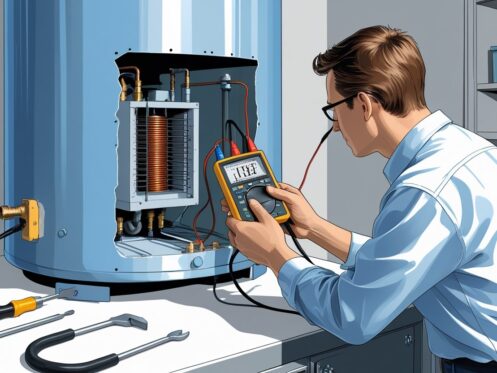Checking the water heater element is essential for ensuring your hot water heater operates efficiently. To test your water heater element, you should first turn off the power to the unit and carefully inspect the heating elements using a multimeter. Familiarizing yourself with this simple process can save you time and prevent costly repairs.
Many homeowners struggle with inconsistent hot water supply, which may indicate a problem with the heating element. By learning how to recognize signs of a faulty element and understanding the testing procedure, you empower yourself to address these issues before they escalate. Splash Plumbing offers quick and reliable services when you need professional assistance.
If you’re dealing with a hot water heater issue, knowing how to test the water heater element can be a game changer. With the right tools and a little guidance, you can determine if your hot water heater needs repairs or if it’s running smoothly. Don’t hesitate to seek advice or assistance from experts like Splash Plumbing to ensure your water heater is functioning optimally.
Understanding Water Heater Elements
Water heater elements are critical for providing reliable hot water. Understanding their types, roles, and differences between upper and lower elements can help you maintain your water heater effectively. These insights are vital for troubleshooting and ensuring the efficiency of your hot water supply.
Types of Water Heater Elements
Water heaters typically feature electric heating elements, which can be classified into two main types: upper and lower elements. The upper heating element is responsible for heating water that you use first, while the lower heating element heats water at the bottom of the tank.
These elements are often made of metal and come with a built-in heating coil. When electric current runs through the coil, it generates heat, warming the water. In some gas water heaters, heat exchangers may serve a similar function. Knowing the different types can help you diagnose problems quickly.
Role of Heating Elements in Water Heaters
Heating elements are essential for heating water within your tank. When you demand hot water, the thermostat activates the appropriate elements. If your water isn’t heating properly, it could indicate a defective element.
For electric water heaters, a multimeter can test the resistance of these elements, with a healthy reading typically between 10 and 30 ohms. If you find lower or zero resistance, it might be time for a replacement. This maintenance can help ensure your hot water supply remains consistent.
Upper vs. Lower Heating Element
The upper heating element is generally prioritized when the tank needs hot water. It heats the water that fills your faucets first. Conversely, the lower heating element serves to maintain the temperature of stored water once it is filled.
In dual-element systems, both elements may operate sequentially or together, depending on the water heater’s design. Understanding the specific function of each can make it easier to troubleshoot issues. If you contact a plumbing service like Splash Plumbing, they can assist you with testing these components to ensure they work properly.
Essential Tools and Safety Precautions
Before testing your water heater element, ensure you have the right tools and follow essential safety measures. Proper preparation is crucial to avoid accidents and secure effective testing.
Required Testing Tools
To test your water heater element, you need specific tools that can ensure accurate readings and safe operation. A digital multimeter is the primary tool for measuring voltage and resistance. You can also use a continuity tester to determine if the element is functioning correctly. For added safety, a non-contact voltage tester allows you to check for live wires without touching them.
Make sure you have screwdrivers for cover removal, and insulation tools for handling any necessary parts. Having basic safety gear, such as gloves and goggles, is a wise choice during any DIY project, ensuring protection against accidental shocks.
Safety Precautions Before Testing
Safety is paramount when dealing with electrical components. Start by ensuring your workspace is clear of clutter to minimize hazards. Always wear personal protective equipment, including insulated gloves and eye protection, when working with electrical systems.
Before proceeding, familiarize yourself with your water heater model. Read its manual for specific safety instructions. Make sure to inspect the condition of electrical wires for any wear or damage. These precautions minimize the risk of electrical shock and ensure a safer testing environment.
Turning Off Power and Disconnecting Power
Turning off the power is a critical step before conducting any tests. Locate your circuit breaker panel and switch off the power to the water heater. Use a voltage tester to double-check that power is indeed off by probing the wires.
Next, disconnect the power wires from the heating element. Ensure you label the wires for easy reconnection later. It’s vital to perform these steps carefully to prevent any risk of electrical shock. Avoid working on live circuits and take all necessary precautions to secure your safety while testing your water heater.
Looking for a plumber near Anaheim, CA? Splash Plumbing is a top-rated plumbing company ready to address all your plumbing issues.
How To Test a Water Heater Element
Testing a water heater element involves several key steps, ensuring that the element is functioning correctly. This process includes accessing the element, performing continuity tests, measuring resistance, and checking for voltage. Each step is crucial for identifying potential issues with your water heater.
Accessing The Heating Element
To begin, you need to access the heating element in your water heater. Typically, this involves locating and removing the access panel on the side of the heater. This panel is usually secured with screws, so use a screwdriver to remove them carefully.
Once you have the panel off, you will see the heating element and its associated wires. Before proceeding, ensure the power to the water heater is turned off at the breaker box. This is critical for your safety. Disconnect the wires connected to the heating element, ensuring they are clearly labeled for easy reattachment later.
Testing For Continuity
With the wires disconnected, you can now test for continuity. This means checking if the heating element has a complete electrical pathway. Set your multimeter to the continuity setting and place the probes on the terminal screws of the element. If you hear a beep, the element has continuity, indicating that it is not broken.
If there is no beep or reading, the element may be defective. Understanding continuity is vital if you want to determine whether the heating element needs replacement or if other issues exist within the water heater.
Measuring Resistance
After confirming continuity, you should measure the resistance of the heating element. Set your multimeter to the ohms setting, typically between the 200 and 1000 ohm scale. Place the probes on the terminal screws again.
A typical resistance reading for a functioning heating element should fall between 10 to 30 ohms. If your reading is significantly higher or shows infinite resistance, the element is likely faulty and should be replaced.
Being precise with your resistance measurement helps ensure that you accurately assess the condition of the heating element.
Checking For Voltage
Finally, check for voltage to ensure the element is receiving power when the water heater is operational. Turn the power back on and set your multimeter to the AC voltage setting. Carefully touch the probes to the terminal screws without breaking contact with the element.
If your multimeter reads approximately 240 volts for an electric water heater, everything is functioning correctly. If there’s no voltage reading, the issue could be with the power supply or the thermostat.
If you’re uncertain or uncomfortable performing these tests, contacting a professional service like Splash Plumbing can provide peace of mind.
Diagnosing Common Problems
Identifying issues with your water heater can prevent further damage and ensure your home remains comfortable. Several indicators point to problems, including malfunctioning elements and thermostats, which can affect water temperature and efficiency.
Symptoms of a Bad Water Heater Element
If your water heater is not producing hot water, or if it’s inconsistent, you might be dealing with a bad heating element. Common symptoms include a complete lack of hot water or lukewarm water that fails to meet your needs.
For electric water heaters, you can test the heating elements using a multimeter. If the reading is not within the specified resistance range, it indicates a malfunction. Further signs can include unusual noises, like popping or cracking, which often signal sediment buildup.
If you consistently encounter these issues, contacting professionals like Splash Plumbing can help diagnose and resolve the problem efficiently.
Identifying Faulty Thermostats
A faulty thermostat often causes improper water heating. If your water heater consistently runs hot and cold or fails to reach the desired temperature, the thermostat may be set incorrectly or damaged.
Check the thermostat setting and ensure it’s correctly adjusted. If it’s been set right but issues persist, you might need to replace it. Thermostats can fail due to age or electrical problems. Regular checks can help avoid further issues down the road, ensuring that you have hot water when needed.
Effects of Power Surges on Elements
Power surges can negatively impact your water heater’s operation. These surges may damage the heating elements directly or cause thermostats to malfunction.
After a power surge, it’s essential to check for burn marks or malfunctions in the heating elements. If you notice that the water temperature fluctuates or there is no hot water at all, have a professional assess the equipment. Splash Plumbing is equipped to evaluate and repair any damage caused by these electrical issues.
Lukewarm Water and Cold Shower Issues
Lukewarm water can be frustrating, often indicating that your water heater isn’t functioning as intended. This problem may arise from a malfunctioning heating element or an incorrectly set thermostat.
Check your thermostat setting to ensure it is appropriately configured for your desired water temperature. If adjustments fail to resolve the issue, further investigation is needed. In some cases, sediment buildup in the tank can also hinder heating efficiency, making professional assistance necessary. Regular maintenance can help prevent these issues and ensure a steady supply of hot water.
Maintenance and Prevention Tips
Proper maintenance of your water heater is essential to ensure its longevity and efficiency. Regular upkeep can help prevent costly repairs and extend the life of your unit.
Flushing The Water Heater Tank
Flushing your water heater tank is critical for removing sediment buildup, particularly in areas with hard water. Sediment can lead to reduced efficiency and shorten the lifespan of the unit.
To flush the tank:
- Turn off the power to the water heater.
- Connect a garden hose to the drain valve at the bottom of the tank.
- Open the drain valve to allow water and sediment to escape.
- Fill the tank with fresh water for a few minutes, then drain again to rinse out remaining sediment.
Doing this once a year helps maintain efficiency and performance.
Preventing Corrosion and Mineral Deposits
Corrosion and mineral deposits are common issues that can impair your water heater. Using a water softener can significantly reduce the hardness of your water, mitigating the accumulation of mineral deposits.
Ensure regular checks for leaks and signs of corrosion. Pay attention to the sacrificial anode rod, which helps prevent tank rust. Inspecting it annually can highlight potential corrosion before it becomes a major issue. If the rod is heavily corroded, consider replacing it to keep your tank in good condition.
Checking and Replacing The Anode Rod
The anode rod is a key component in preventing corrosion within the water heater tank. Inspect the anode rod every one to two years. If you notice it is less than half an inch thick or heavily corroded, it is time to replace it.
To check it, turn off the power, drain some water from the tank, and remove the anode rod from its fitting. Replacement rods are easily available and are crucial for maintaining the longevity of the tank. If you’re unsure how to proceed, consider professional assistance from a trusted service like Splash Plumbing. They can help you with maintenance and inspections to ensure your system runs smoothly.
Frequently Asked Questions
This section addresses common inquiries related to testing and maintaining water heater elements. Each question provides specific guidance to help you understand the processes and options available.
What steps are involved in testing a water heater element with a multimeter?
To test a water heater element using a multimeter, first, ensure the power is turned off at the breaker box. Remove the access covers on the water heater and disconnect at least one wire from the heating element. Set the multimeter to the ohms setting and probe the terminals of the element. A reading of 10 to 30 ohms indicates a functional element. If the reading is infinite, the element is faulty.
How can I test a water heater element if I don’t have a multimeter?
If you lack a multimeter, you can conduct a visual inspection. Check for any signs of burn marks or corrosion on the heating element’s terminals. Additionally, you can inspect if the water heater is producing hot water. If the heater fails to warm water, it may indicate an issue with the element.
What is the procedure for checking the functionality of a water heater thermostat?
To check a water heater thermostat, turn off power at the circuit breaker. Remove the thermostat cover to access the components. Use a multimeter to measure continuity between the terminals. If the meter shows continuity when the thermostat is calling for heat, it’s functioning properly. If it does not, the thermostat may require replacement.
How can I determine if my water heater element is faulty?
Signs of a faulty water heater element include inconsistent water temperature and reduced hot water supply. If you observe these symptoms, use a multimeter to test the resistance of the element. A reading outside the normal range suggests the element is defective and should be replaced.
Is it possible to test a water heater element without emptying the tank?
Yes, you can test a water heater element without draining the tank. Simply turn off the power, disconnect one wire from the element, and then use a multimeter to check for resistance. This allows you to assess the element’s condition without needing to empty the tank.
What are the instructions for replacing a water heater element?
To replace a water heater element, first, turn off the power and water supply to the unit. Next, drain the tank if necessary. Remove the access cover and disconnect the wires from the old element. Unscrew the old element using an appropriate tool and replace it with a new one. Reconnect the wires, seal the access cover, and restore power to the unit. If you’re unsure about the process, consider contacting a professional like Splash Plumbing for assistance.












